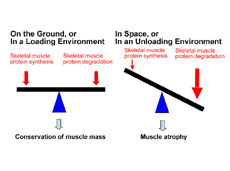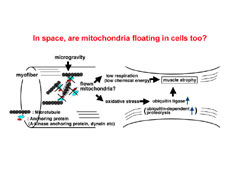
Why do muscles atrophy in space? Space is an extreme environment for all living beings - humans, animals and vegetation - for several reasons: there is a vacuum (no air), microgravity, cosmic radiation, hypergravity during launch, and confined quarters. Prolonged stays in space trigger medical problems such as loss of bone density, exposure to cosmic radiation, and mental stress. My research focus is on skeletal muscle atrophy.

Muscles are made up primarily of proteins. Muscle proteins are continuously in a process of degradation and synthesis. A balanced muscle protein mass sustains a certain muscle mass, but when you are in space or laid up in bed for a long period of time, that balance is lost. This happens because of decreased synthesis and increased degradation of muscle proteins (Figure 1), which causes muscle loss. In 1998, about 100 rats were sent to space on the Space Shuttle, and experiments revealed that their muscles became drastically atrophied. Even though these rats were floating in a microgravity environment, they had continued to move around. Yet, in spite of that, some of their muscles atrophied by almost half in their roughly two-week stay in space. After the rats were returned to Earth, we tested the proteins in their muscles (gastrocnemius muscle), and found that ubiquitinated proteins were drastically increased. Let me explain what ubiquitins are. When you check in your luggage at the airport, they put a label on it that indicates the destination. Similarly, a ubiquitin is like a label put on a protein that's to be broken down. When ubiquitins are added, we call it ubiquitination. In summary, we discovered that in space skeletal muscle atrophy is induced by an increase in the number of proteins that are tagged for degradation. The question, then, is why proteins are ubiquitinated in space with microgravity. In other words, why do muscles atrophy in space? It's presumably because the muscle cells themselves are perceiving gravity or the lack of gravity. Based on this speculation, we decided to study the variation of gene expression, because we thought it might reveal how muscles sense gravity.
We analyzed genes that were expressed in the space environment, and genes that were largely expressed on the ground. What we found was that, when the environment changes, the expression of some genes increases while that of other genes decreases. Without going into too many details, when skeletal muscle cells are exposed to the space environment, there is a dramatic increase of expression of the gene for the enzyme that induces ubiquitination (ubiquitin ligase). On the other hand, expression of the gene that regulates mitochondria organelles is abnormally decreased. Mitochondria are sustained by proteins, so when proteins are decreased, mitochondria alignment is disordered. When we stained mitochondria, it became apparent that the local existence of mitochondria in the space rats' skeletal muscles was in disorder. It's possible that in space, mitochondria are floating within their cells - just like people float in a spacecraft (Figure 2). Furthermore, mitochondria generate energy (ATP) from oxygen, but when they are improperly aligned, they cannot function properly. This results in a malfunction in the production of ATP. And not only that, it creates active oxygen (oxidative stress), because oxygen cannot be metabolized as normal. I presume that oxidative stress increases expression of ubiquitin ligase, which then induces muscle atrophy. Luckily we have an opportunity to carry out experiments two years from now with the Japanese Experiment Module Kibo of the International Space Station. I hope to learn more about this mechanism - how muscles perceive gravity - in space.
If we can solve the problem of muscle atrophy caused by weightlessness, it will enable humans to stay in space longer. We'll also be able to design a medical treatment for skeletal muscle atrophy from long-term immobility. Today, skeletal muscle atrophy caused by aging or lying in bed is treated through exercise training, rehabilitation and a special diet, but this doesn't seem enough to me. We're now working with a food manufacturer on developing new foods that prevent muscle atrophy. We think that one key is finding a nutrient that prevents proteins from ubiquitinating - in other words, a nutrient to interfere with enzymes breaking down proteins. And we've found the answer in oligopeptides, nutrients comprised of amino acids. We're still in the development phase, but I'd like to continue the research towards commercialization. I am sure that our experiments will bring great results.

Muscles are made up primarily of proteins. Muscle proteins are continuously in a process of degradation and synthesis. A balanced muscle protein mass sustains a certain muscle mass, but when you are in space or laid up in bed for a long period of time, that balance is lost. This happens because of decreased synthesis and increased degradation of muscle proteins (Figure 1), which causes muscle loss. In 1998, about 100 rats were sent to space on the Space Shuttle, and experiments revealed that their muscles became drastically atrophied. Even though these rats were floating in a microgravity environment, they had continued to move around. Yet, in spite of that, some of their muscles atrophied by almost half in their roughly two-week stay in space. After the rats were returned to Earth, we tested the proteins in their muscles (gastrocnemius muscle), and found that ubiquitinated proteins were drastically increased. Let me explain what ubiquitins are. When you check in your luggage at the airport, they put a label on it that indicates the destination. Similarly, a ubiquitin is like a label put on a protein that's to be broken down. When ubiquitins are added, we call it ubiquitination. In summary, we discovered that in space skeletal muscle atrophy is induced by an increase in the number of proteins that are tagged for degradation. The question, then, is why proteins are ubiquitinated in space with microgravity. In other words, why do muscles atrophy in space? It's presumably because the muscle cells themselves are perceiving gravity or the lack of gravity. Based on this speculation, we decided to study the variation of gene expression, because we thought it might reveal how muscles sense gravity.
We analyzed genes that were expressed in the space environment, and genes that were largely expressed on the ground. What we found was that, when the environment changes, the expression of some genes increases while that of other genes decreases. Without going into too many details, when skeletal muscle cells are exposed to the space environment, there is a dramatic increase of expression of the gene for the enzyme that induces ubiquitination (ubiquitin ligase). On the other hand, expression of the gene that regulates mitochondria organelles is abnormally decreased. Mitochondria are sustained by proteins, so when proteins are decreased, mitochondria alignment is disordered. When we stained mitochondria, it became apparent that the local existence of mitochondria in the space rats' skeletal muscles was in disorder. It's possible that in space, mitochondria are floating within their cells - just like people float in a spacecraft (Figure 2). Furthermore, mitochondria generate energy (ATP) from oxygen, but when they are improperly aligned, they cannot function properly. This results in a malfunction in the production of ATP. And not only that, it creates active oxygen (oxidative stress), because oxygen cannot be metabolized as normal. I presume that oxidative stress increases expression of ubiquitin ligase, which then induces muscle atrophy. Luckily we have an opportunity to carry out experiments two years from now with the Japanese Experiment Module Kibo of the International Space Station. I hope to learn more about this mechanism - how muscles perceive gravity - in space.
If we can solve the problem of muscle atrophy caused by weightlessness, it will enable humans to stay in space longer. We'll also be able to design a medical treatment for skeletal muscle atrophy from long-term immobility. Today, skeletal muscle atrophy caused by aging or lying in bed is treated through exercise training, rehabilitation and a special diet, but this doesn't seem enough to me. We're now working with a food manufacturer on developing new foods that prevent muscle atrophy. We think that one key is finding a nutrient that prevents proteins from ubiquitinating - in other words, a nutrient to interfere with enzymes breaking down proteins. And we've found the answer in oligopeptides, nutrients comprised of amino acids. We're still in the development phase, but I'd like to continue the research towards commercialization. I am sure that our experiments will bring great results.
Dr. Takeshi Nikawa
Professor, Department of Nutritional Physiology, Institute of Health Biosciences, University of Tokushima Graduate School
Dr. Nikawa graduated from the University of Tokushima Faculty of Medicine in 1987, and received his Ph.D. in 1991. The following year, he went to Germany to study biochemistry at Heinrich-Heine-Universität Düsseldorf. He became an assistant professor of the University of Tokushima Faculty of Medicine School of Nutrition in 1994, and an associate professor in 2003. He has been in his current position since September 2007.
Professor, Department of Nutritional Physiology, Institute of Health Biosciences, University of Tokushima Graduate School
Dr. Nikawa graduated from the University of Tokushima Faculty of Medicine in 1987, and received his Ph.D. in 1991. The following year, he went to Germany to study biochemistry at Heinrich-Heine-Universität Düsseldorf. He became an assistant professor of the University of Tokushima Faculty of Medicine School of Nutrition in 1994, and an associate professor in 2003. He has been in his current position since September 2007.

